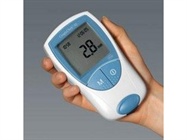Featured Article

Please check out our Clinical Diagnostics section, Point of Care Devices (POC Diagnostic Devices) section, and Coagulation Analyzer/Microcoagulation System section to find manufacturers that sell these products
The prothrombin time (PT) is an assessment of the extrinsic and final common pathways of the coagulation cascade. In the laboratory, PT is determined by adding calcium and tissue factor (factor III) to a plasma sample from the patient’s blood, which has been collected in a blue-top tube containing 3.2% concentrated citrate, and measuring the time until formation of a fibrin clot.
Importance of the CLIA-Waived Test
The indications for performing PT testing include monitoring the anticoagulant effects of coumarin drugs such as warfarin sodium; assessing patients with signs or symptoms of abnormal bleeding or thrombosis; evaluating patients who might have inherited conditions, such as hyperhomocystinemia, elevated factor VIII levels, dysfibrinogenemia, factor XII deficiency, and disorders of plasmin generation; and assessing patients with acquired conditions, such as pregnancy, postoperative problems, and antiphospholipid syndrome. Testing for PT along with serum aspartate aminotransferase and alanine aminotransferase levels is also performed to assess liver function. Given the broad applicability of PT testing, and the concern that some patients needing anticoagulation may not be receiving warfarin because of the scarcity of testing centers, prompt and accurate determination of PT at the point-of-care and at home is highly desirable.
PT and Target INR
The PT is reported as the clotting interval (in seconds) or the International Normalized Ratio (INR), which was developed to standardize the PT for patients receiving warfarin. Target INR values vary, depending on the reason for anticoagulation therapy. For example, patients with atrial fibrillation or needing hip surgery, who are being anticoagulated to prevent stroke or deep vein thrombosis, respectively, should have target INRs of 2–3. Patients with an artificial heart valve should have INRs ranging from 2.5–3.5 to prevent arterial thrombosis.
Several manufacturers have been granted CLIA-waived status for their PT testing instruments. In addition, they have developed novel point-of-care technology that can test fingerstick samples of whole blood, enabling self-testing in the patient’s home. However, because of the narrow therapeutic window for efficacy versus major bleeding such as intracranial hemorrhage, it is essential that any CLIA-waived PT testing system provide reliable INR values. A European Community-approved quality assessment plan is in place for CoaguChek® point-of-care monitors (Roche Diagnostics Corp., Indianapolis, IN), which are widely used in Europe.
- Roche Diagnostics Corp. offers the CoaguChek XS Plus System for health-care professionals, to enable on-the-spot monitoring of PT/INR values in the office in less than 1 min on 8 μL of capillary blood. The system includes the CoaguCheck Plus meter and test strips. Optional controls are also available. The device employs electromagnetic field kinetics to determine PT. A single drop of whole blood is applied to a test strip containing human recombinant thromboplastin, thereby initiating the coagulation cascade. Alternating magnetic fields in the cocktail cause preincorporated iron particles in the strip’s reaction chamber to move. An endpoint is reached when the formation of a clot causes immobilization of these particles. Roche Diagnostics also offers the CoaguCheck XS System, which consists of a meter and test strips, for patients to use at home.
- International Technidyne Corp. (Edison, NJ) manufactures the CLIA-waived ProTime® Microcoagulation System to monitor the clotting activity in patients on warfarin anticoagulant therapy. The system analyzes fingerstick whole blood samples and displays test results as INR and PT in 4–5 min. It consists of a ProTime instrument, a reagent cuvette (either the standard ProTime, which performs triplicate testing of the PT assay along with controls, or the ProTime3 cuvette, which performs singlet testing), and the Tenderlett® Plus incision device. The system has also been approved for patient self-testing, and is available by prescription. ProTime runs two levels of quality control with each patient sample and automatically checks quality control with each test.
- Alere San Diego, Inc. (San Diego, CA) offers the Alere INRatio®/INRatio®2 PT/INR monitoring systems, which consist of a small monitor and disposable test strips. The monitor evaluates a drop of fingerstick blood that has been applied to an INRatio PT/INR test, and provides the PT and INR in about 60 sec. It performs quality control for every test. The test strip contains coagulation factors extracted from human plasma, along with buffers. Testing can be performed in the physician’s office or by the patient at home. For point-of-care use, the results can be printed out using the Alere INRatio Printer, and the monitor can also be connected to a computer using PC ConnectTM software.
Please check out our Clinical Diagnostics section, Point of Care Devices (POC Diagnostic Devices) section, and Coagulation Analyzer/Microcoagulation System section to find manufacturers that sell these products